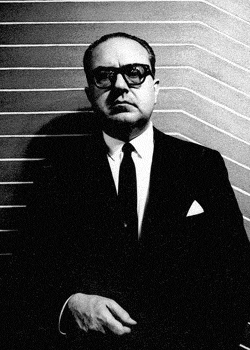Alberto Ginastera Centennial - 2016
-
-

Of all the composers in Latin America creating a body of work in the new aesthetic that came with the 20th century, perhaps none were more influential than Alberto Ginastera. Born in 1916, Ginastera came to prominence in his home country of Argentina, quickly garnering the admiration of the musical elite and catching the eye of the political powers that be. Although Ginastera’s relationships with Argentina’s multiple regimes ranged from friendly to tumultuous, his effect on the musical and political discourse of Latin America inspired a wave of artistic independence and experimentation that continues today.
Ginastera maintained relationships with some of the most respected composers and conductors of his day; Leonard Bernstein and Aaron Copland both played vital roles in bringing his music to the American concert-going public. Establishing relationships with performers, conductors, and presenters, Ginastera often traveled to cities such as New York, Washington, D.C., Philadelphia, Los Angeles, Vancouver, Frankfurt, London, Zurich, Madrid, and Rome. It was in these international cultural hubs where the composer found an outpouring of appreciation and interest in his work, ranging from the rustic and familiar modality of Estancia to the aleatoricism of Popol Vuh: The Creation of the Mayan World. Ginastera would become a fixture on programs highlighting the best of the current generation of composers.
A cosmopolitan man with visceral sensibilities, Alberto Ginastera’s galvanizing voice is heard through the operas, ballets, concertos, tone poems, quartets, and piano works that have shaped a culture and given the next generation license to explore all musical possibilities. In 2016, we celebrate the centennial of Alberto Ginastera.
"Beauty is the emergence of a spiritual climate in which each artist is transfigured through the impulse of creation. In this climate, the work that springs forth from the depths of his soul, combining personal and shared elements of humanity, is purified and becomes translucent and clear. It becomes universal."
—Alberto Ginastera -
We invite you to explore this page to learn more about the life and music of Alberto Ginastera
>>Composer Page
>>Biography
>>Audio/Video
>>Online Scores
>>Publications
>>List of Works
Alberto Ginastera was the leading Argentinian composer of the twentieth century. He was born in Buenos Aires in 1916 and studied musical privately as a child, later enrolling at the National Conservatoire of Music in his home city.
In 1946-47 Ginastera spent a year in the United States on a Guggenheim fellowship, joining the teaching staff of the National Conservatory upon his return home; he was later the Dean of the Faculty of Musical Arts and Sciences at the Catholic University. His first opera, Don Rodrigo, was premiered to immediate acclaim in 1966 and was soon followed by two others, Bomarzo (1967) and Beatrix Cenci (1971).) In 1969, finding himself out of sympathy with the prevailing political climate in Argentina, Ginastera left the country, settling in Geneva.
In the early 1950s the nationalist element in his music gradually lost its dominance, and more explicitly modernist characteristics began to make their presence felt in what Ginastera called his ‘neo-expressionistic period’. He actively adopted the twelve-tone technique and his works also incorporated microtones and polytonality. By the time of his death, on 25 June 1983, his modernism had softened, and he began to look again at the tonality and folk-music inflexions of his early output.
Cello Concerto No. 1 Op. 36 (1968) II. Presto sfumato - Trio notturnale
Piano Sonata no. 1, op. 22 (1952). II. Presto Misterioso
Variaciones Concertantes, op. 23 (1953). XII. Variazione finale in modo di Rondo per Orchestra
String Quartet No.2 op. 26 (1958)
Click the links below to view the online perusal score for each piece.
>Estancia - Ballet in One Act
>Harp Concerto, opus 25
>Variaciones Concertantes for Chamber Orchestra
>Concerto pour Cordes
>See moreSuite de danzas criollas, Op. 15 and Rondó sobre temas infantiles argentinos
Edited and recorded by Michael Mizrahi
A newly researched and engraved edition with extensive performance notes and a composer biography. The price of the publication includes access to companion recorded performances online for download or streaming by the editor.
Publisher Code: M051246632
Width: 9.0"
Length: 12.0"
40 pagesDanza Final from Estancia: Young Strings Edition
Arranged by Robert Longfield
Now available for strings, Alberto Ginastera's well-known finale to his Estancia ballet is steeped in South American folk style. The familiar cross rhythms give this “malambo” an infectious feel – a classic work for contest and festival consideration.
UPC: 884088255626
Width: 9.0"
Length: 12.0"
Run Time: 0:02:30Danza Final from Estancia: Band Edition
Arranged by Robert Longfield
An adaptation of his famous Danza Final from the ballet Estancia in a version for younger players. Still rhythmically dynamic and authentically arranged, this will be an exciting addition to any concert program. (Grade 3.5)
UPC: 884088258139
Width: 9.0"
Length: 12.0"
Run Time: 0:02:30
Includes part for Harp and Piano Reduction.Softcover
Publisher Code: M051380145
Width: 8.5"
Length: 11.0"
64 pages
Performances
Click here to view a complete list of performances of Ginastera's music. You can use this page to sort by country, ensemble type, date, and whole host of additional parameters.





